Corporate Social Investment
KZN Slots contributed to 10 provincial beneficiaries contributing towards health, education and community development in KwaZulu-Natal.
- Download our CSI Beneficiary Application and Information Guide for more information.
- Download our CSI brochure
2022
Robin Hood Foundation
The Robin Hood Foundation started informally in May 2005 and grew exponentially due to the needs of the community and two years was registered as an NPO. The Foundation has 4 major projects, namely: - Gogo Bags; Love the Babies; Bless a Granny & Grandpa and Hope Breakfast (Child Headed Household). Each project done under the Child Headed Household banner is specifically aimed at orphaned and vulnerable cases and assistance of the Community Liaison is necessary. KZN Slots took this a step further and have funded 10 scholars for the duration of the last five academic years, ensuring that not only do they have their school uniform and stationary needs met, but that their home has the basic food needs met as well. We have annual visits with the children and this year we spent the day at Mini Town.
• BBBEE - 100% Black Beneficiaries
• Amount - R100 000
“Your generosity helps us to continue to help the disadvantaged in our community. Thank you for your kind and continued support, it is greatly appreciated.” – Jackie Pannis, Co-ordinator at Robin Hood Foundation.”
Isisekelo Pre-Primary
Oscarsberg Primary School is located within Umzinyathi District in Msinga Local Municipality. It is a no fee public Primary School. With a 30% growth in pre-school intake, there was a need for Isiseklo Pre- Primary School to be opened to meet the needs of the community. Nutrition during school years is crucial for the physical, mental, and psychosocial development of children and yet it is estimated that, across Africa, 23 million school children go to school every day hungry. Benefits of school feeding programmes on children and adolescents assist with alleviating hunger, reducing micronutrient deficiency and anaemia, improving school enrolment and attendance, increasing cognitive and academic performance, and contributing to gender equity in access to education. This School wanted to improve the quality of meals by building a small kitchen where meals can be prepared by their own housekeeper ensuring they eat a nutricious, balanced and tasty snack and hot lunch every day. These two meals are frequently the main source of nutrition available to the school’s learners.
• BBBEE – 100% Black
• Amount – R50 000
“The children, parents and teachers at Isisekelo Preschool, Rorke’s Drift would like to thank you most sincerely for the generous donation towards the building of a preschool kitchen for Isisekelo Preschool. We are very excited about this project and so grateful for your support”. - Mrs Zodwa B.M. Zulu Principal: Oscarsberg Primary School.
Reach for Recovery
Reach for Recovery is an international, non-profit breast cancer Organisation that was established in South Africa in 1967. All Volunteers are breast cancer survivors, who have been through the journey of diagnosis, surgery, treatment and recovery. The Volunteers are well trained and equipped to offer emotional and practical support to breast cancer patients and their families. Breast Cancer Awareness also forms a vital part of their strategy, as early detection is the key to survival. Reach for Recovery is a breast cancer support Organisation with a unique focus on breast cancer support and one of the only organizations’ that provide a patient support service on a national basis. This service is done at no charge to the patient and is available to any woman who requests it. Mammograms are a diagnostic life-saving tool.
• BBBEE – 91% Black
• Amount - R19 500 (ten mammograms)
“This generous donation will go towards our 2022 mammogram campaign, and will provide 10 Mammograms for disadvantaged women who have a high risk of breast cancer. Thank you once again, to KZN Slots for this potentially lifesaving gift, and helping us make a real difference in KZN”. -Jenny Caldwell, Regional Chairperson KZN.
Jes Foord Foundation in collaboration with Six Soccer League
Six Soccer League is the community soccer league that was formed in 2020 with 11 clubs and the second season 2021, has grown to 16 clubs and this year 2022 expanded to 18 clubs. The league has a huge impact in the community and has a large number of supporters attending fixtures. Focus is not only on football but also on the holistic development of youngsters in the area to tackle social ills affecting the community. They work closely with Communications Officer and Social Crime Prevention Coordinator at Hammarsdale SAPS, as well as Crime Prevention Officer at Mpumalanga SAPS. The league is based in Mpumalanga Towship and all matches are played at Unit 6 Soccer Field. The tournament will comprise of 18 clubs and is organised with the following objectives: • To expose the existing abundant soccer talent from young people in Hammarsdale • To promote unity to the community through universal language of sport • To promote active participation in sport as a health consciousness tool and also take young people off the streets • To raise awareness of social ills in the township such as crime, drug abuse, sexual assault, HIV/Aids and Gender Based Violence • To raise community awareness of the Jes Foord Foundation, its role; mission and how the organisation helps in restoring lives after rape and more importantly working with young boys in the community to improve to the mindset regarding social ills.
• BBBEE – 100% Black • Amount - R18 800
“Thank you to KZN Slots for the donation towards our annual soccer tournament with the black youth in Hammersdale. You have no idea how this type of event helps us reach so many young men with the important message of consent. Your support is so appreciated. Its people like yourself who make our job of turning “Rape Victims” into “Rape Survivors” that much easier to do”. – Jes Foord, Founder of the Jes Foord Foundation.
ForAfrika SA
The Early Childhood Development (ECD) feeding programmes reach approximately 120 000 pre-school children in 3 000 centres; operate in all nine provinces, providing children with a highly nutritious meal every school day. The Organisation believes that hungry children cannot learn and without education, there can be no development. Sadly, in South Africa, approximately two million children go to bed hungry each night. These children miss out on the vital nutrients necessary for their physical and cognitive development, which may have a devastating effect on their future. 90% of a child’s brain development happens before the age of five, and adequate nutrition is crucial for mental growth. Without it, the scars of stunting follow a child and affect their prospects for health, learning and success throughout their lives. Nutrition is the foundation for children to achieve their full potential and the best chance at a brighter future. For Afrika feeds children in preschools and assists the surrounding communities by increasing food security by empowering families and individuals. Their programmes meet the immediate needs of malnutrition, and address development through multi-level training and extensive agricultural programmes. Their motto – A sprinkling of nutrients can change a child’s life.
• BBBEE – 100% Black
• Amount – R30 000
“This is the time to build the foundation of cognitive and character skills necessary for success in school, health, career, and life in general. Investing in our young children is the best seed we can sow into the future. ECD and nutrition are intrinsically related. Sadly, at least two million South African children go to bed hungry every day. This means the future of the nation is crippled as the very children who are supposed to mold it are stuck in underdevelopment caused by malnutrition. Through your support, you help ForAfrika to bring nutrition, development, and stimulation to many thousands of children and thereby giving them a chance for a better future. Your donation is indeed a seed into the future! Thank you for securing hope for a brighter tomorrow!” – Sindile Kubayi - Corporate Partnerships
East Coast Radio
KZN Slots partnered with East Coast Radio’s Breakfast Team to help with their ‘Big Favour’ initiative. The Big Favour is synonymous with bringing communities together to help make wishes come true and one finds the spirit of Ubuntu, at its core. KZN Slots shares this calling to assist and has sponsored R70 000 to East Coast Radio and was able to assist with three requests.
The recent floods in KZN caused Bheki Nduli to lose everything. He was residing in an outside toilet where he was also cooking and sleeping. He sent his family to live with relatives. Being the sole bread-winner and having several family members financially dependent on him, made it extremely difficult to save money to rebuild. His colleague, Pravashini Nayagar, nominated him. KZN Slots assisted him with R30 000 towards the rebuilding of his home. Bheki was extremely grateful and so in awe of this kind gesture.
Nompilo Dlamini wrote into East Coast Radio Big Favour on behalf of three boys residing in the local Inanda Community, namely: -
• Sibusiso Hlongwa representing the under 14 Team;
• Philasande Mkoyana representing the under 16 Team; and
• Prince Mncube representing the under 18 Team
These boys were selected to represent KZN Rugby Union Sharks Youth Club at a provincial tournament in Bloemfontein. The tournament costs R9000 per player. Chatting with these boys, their love for the sport shines brightly. It was clear to our Team that affording them this opportunity will improve their skill set, open doors for them in terms of the sport, as well as will give them access to school sports scholarships. Consequently, having a positive impact on the boys and on their community.
Candice Te Brugge nominated Prudence Mpisane, her children’s nanny. She requires assistance to replace her roof. These ladies share a lovely bond as Mum’s trying to do their very best for their families. Prudence is the sole bread-winner of a family of five, residing in a small home. Her circumstances aggravated, as her husband is ill with cancer. She describes the state of their roof as, ‘abestos falls like rain everyday’. She requested assistance to replace the asbestos with corrugated sheets of steel. KZN Slots has assisted Prudence and her family in the amount of R13 000 to replace her roof. Prudence and Candice were extremely emotional and ever so thankful. (Letter of thanks available, should you want to use an extract).
TREE
The Organization has been in existence for the last 38 years providing training and capacity development to the Early Childhood Development Workforce. Their focus is on empowering women from rural, most deprived communities. TREE has training centres in KwaZulu Natal in three cities, Ladysmith, Durban and Port Shepstone and provides educational resources that are age appropriate to children to facilitate quality early learning programmes which are aligned with the National Curriculum Framework as outlined in the 2015 ECD Policy. TREE uses waste recycled wooden materials and other relevant accessories to make educational toys that are inclusive for all children. These toys are sold at the toy shop on premises, to the public. There is a diverse range of educational toys in this toy shop which helps the Organization generate income for recovery costs and sustainability. KZN Slots assisted with the maintenance and refurbishment of toy libraries and the toy workshop.
• BBBEE – 100% Black
• Amount – R50 000
“We at TREE would like to express our profound gratitude to you and your organisation, "thank you" is not enough to express our appreciation for your kind donation. We are happy to let you know that these funds continue to serve the most vulnerable communities by providing essential ECD services and programmes, nourishment, and community development. Without your financial donation, we would not be able to continue our work of empowering women, and men within the ECD sector, all while laying the foundation of success for our young children’s future outcomes”.
– Ruby Matoung, Executive Director TREE
Valley Trust
The Valley Trust (TVT) was established in 1953 as a socio-medical centre for health promotion in the Valley of a Thousand Hills (the valley) in the Outer West region of eThekwini, KwaZulu-Natal. Its vision is to use health and other means to ensure that the rural communities of the valley lead vibrant lives as full participants in a democratic South Africa. In its long and distinguished history, TVT has worked with local stakeholders to bring much-needed development in its target area including the introduction of piped water, roads, recreation halls and promoting the establishment of household and communal vegetable gardens. TVT has also formed strong bonds with local stakeholders and works closely with traditional and elected (municipal) leadership, local structures, government departments and other non-profit organisations.
In 2021, TVT began an intervention to help households develop their own vegetable gardens in order to improve nutritional intake and reduce expenditure on basic food needs. The vegetable gardens are customised for each household and based on the foods that each household consumes the most. The year focused on training 13 TVT staff members and 66 heads of households in what the intervention will entail. 2022 will continue the training and see caregivers implement the knowledge gained through starting gardens in their homes. As at January 2022, 11 gardens had been established. TVT works with agricultural consultancy GN12 Farms & Montorship (Pty) LTD who specialise in training small- and large-scale farmers in crop or animal production for domestic or commercial purposes. In 2021, GN12 began with training TVT staff and selected households in setting up vegetable gardens. In 2022, GN12 will continue with training and providing mentorship and support to ensure the success of the initiative.
• BBBE – 100% Black
• Amount – R20 000
“On behalf of Valley Trust, I would like to thank you for your contribution to our development work. Your donation will be used to further the work that TVT does in assisting communities in the Valley of a Thousand Hills improve their health and quality of life”.
– S Vilakazi, Executive Director, The Valley Trust.
SA Mobility for the Blind Trust
SAMBT has trained nearly 5,000 blind and partially sighted people since inception in 1998, from deep rural areas in Manguzi, to Osizweni, Madadeni and Utrecht, as well as at schools for the blind. They have 41 training programmes in 8 of the 11 District Municipalities. They have a radical outreach approach, running programmes in areas that are under-served or not served at all. Orientation and Mobility (O&M) teaches white cane techniques and orientation skills. This makes it possible for blind people to get about freely and independently without the assistance of sighted people. O&M training is the key for day-to-day well-being of blind people; and promotes social and economic integration. The benefits are not only practical but also emotional and psychological. Activities of Daily Living (ADL) is part of orientation and mobility training. It teaches ways to carry out common daily tasks including cooking, using a telephone, using an auto bank, recognising coins and banknotes, etc.
There are over one million blind and severely visually impaired people in South Africa and there are only about 46 Orientation and Mobility (O&M) practitioners in the whole of the country who are qualified to provide them with Independence Training. (A practitioner holds a two-year diploma from the College of O&M in Johannesburg). The Department of Basic Education recognizes the importance of Independence Training for the children at its 22 schools for the blind, but it is not able at the moment to create posts for qualified practitioners in this field. The sane applies at the Department of Health when it comes to its rehabilitation service. And so, there are thousands of blind children who are not getting Independence Training and many more adults than that. Most of those adults live in rural and township areas assisting the Organisation with sponsorship toward the training of 12 blind and partially sighted people in rural Mtubtuba area to become independent through focused one on one training. The training includes white cane skills as well as how to do seemingly simply daily activities alone - without the need for sighted help.
• BBBEE – 100% Black
• Amount – R75 000
“Our biggest achievement at SAMBT, hands down, is every time a new blind client learns how to get around with his or her white cane on their own. We know how easy it is to forget what courage it takes for a blind person to start walking around without hanging onto someone’s arm.
Our practitioner Thabang recently trained Nthabiseng, who was especially fearful to move around on her own. Although Nthabiseng wasn’t even able to acknowledge her own fear, Thabang realised just how scared Nthabiseng was, recalling her clients’ voice “what if I fall, what if I….” And then, thanks to Thabang’s patient and skilful training, Nthabiseng’s confidence grew to the point, where Thabang started following her some steps behind, all the way building Nthabiseng’s confidence . And so on the day that Nthabiseng got herself to the shop on her own for the first time, the shopkeeper, in awe, exclaimed, “oh wow, you came here all by yourself!” And with that he shoved a whole hand full of sweets into her hand. As they left the shop, Nthabiseng paused to soak in the moment, “You know Thabang, I did not believe you at first that I will be walking on my own”.
Well, Thabang, knew and believed all this, and more. This is the power of our in-depth independence training. And this December holiday, Nthabiseng’s father’s pride in his daughter will be clear to any visitor who he will tell: “I had a lunch that was cooked by my daughter”.
Thank you KZN Slots, for being part of several Nthabiseng’s independence this year.”
- Helen Vosloo Assistant to Managing Trustee, SAMBT
Lungisane Indlela
In 2007 Lungisani Indela was birthed out of a non-profit organization called Indela. The vision of Lungisani Indlela is to transform and empower the lives of the people and children of the Amaoti community, bringing them hope for the future. Their vision and mission is to see every child in a crèche or school; to see the Amaoti crèches and schools transformed and reach a standard of excellence; to see every orphan cared for; entrepreneurial businesses established within Amaoti; and to see sports, dance, drama, art and crafts introduced. In essence to see that no-one will be idle as they develop a transformed work and play ethic. They believe that community development is the most appropriate action to combat poverty. Such development needs to incorporate the social, and physical well-being of each individual (holistic approach), focusing on the old adage of ‘teach the people to fish’. As the African Proverb says ‘It takes a village to raise a child’. This means that it takes more than one person to teach a child the ways of life. KZN Slots assisted the Organisation with installation of an awning at their Safe House to create a space for the children to do their extra lessons, as well as learn arts and crafts and create items that they can sell and improve their circumstances.
• BBBEE – 100% Black
• Amount – R24 800
“I would like to stress our heartfelt gratitude and appreciation for your generous donation towards the installation of the awning. It is with businesses & individuals like you that we are able to make a difference in the community of Amaoti, the largest informal settlement in Durban with many people struggling to meet basic needs; and are facing crisis on a daily basis. Children and the elderly are especially vulnerable. Lungisani Indlela Trust was established for the purposes of bringing transformation and empowerment to the lives of the children and people of Amaoti. We are so grateful for your partnership in helping these children to access basic needs as well as being loved, nurtured & restored. Your donation really does make a huge difference in our operations, as well the lives of these precious children”.
- innocent Msani, General Manager Lungisani Indlela Trust.
2021

Robin Hood Foundation
Contributed R100 000
The Robin Hood foundation started informally in May 2005 and grew exponentially due to the needs of the community and in 2007 was registered as an NPO. The Foundation has 4 major projects, namely: - Gogo Bags; Love the Babies; Bless a Granny & Grandpa and Hope Breakfast (Child Headed Household). Each project done under the Child Headed Household banner is specifically aimed at orphaned and vulnerable cases and assistance of the Community Liaison is necessary. KZN Slots took this a step further and have funded 10 scholars for the duration of the last five academic years, ensuring that not only do they have their school uniform and stationary needs met, but that their home has the basic food needs met as well. We have annual visits with the children and this year we spent the day at uShaka Marine World.
BBBEE - 100% Black Beneficiaries.
Sponsorship – Uniform, school and daily requirements for underprivileged children and child headed- households
“Thank YOU and YOUR team for the lifeline you give these children, a blessing that I don’t think we’ll EVER know the full extent of xxx”
– Kim Griffith Jones, Co-ordinator Robin Hood Foundation
Dedenthu Primary School
Contributed R95 000
Dendethu Primary School was originally built in 1980 by parents from the local community who contributed R15 each, at that time, to build the first block at the School. It is a no-fee school in the impoverished rural community of Mandeni. The school caters for 310 Learners and has 11 teachers; a security guard; a cleaner; a screener and 2 food handlers. Just over half the Learners are orphaned or come from child-headed and granny- headed households. Most parents earn a marginal income with little local work opportunities. The School has a passionate Governing Body that strives to attain funding for the improvement of the school. They have requested assistance to maintain the school grounds. Without the necessary equipment the grass around the school grows up to a metre long with is dangerous to the children, in that it encourages snakes and crime. Hence the dire need to maintain the School's premises. Further, there is no shaded area for the children to sit under to have their lunches or protect them from the weather.
BBBEE - 100% Black Beneficiaries
Sponsorship – purchasing of the grass cutters; sponsoring the installation of the awning and assisting with the maintenance of the school grounds
“On behalf of the Student Governing Body, the Staff, the Learners and the Parents of Dedenthu Primary School I wish to express our heartfelt gratitude for the most important donation you have afforded us in order to build an area where learners can sit and enjoy their meals during break. Having a decent area will boost learners’ dignity and self-esteem and make them feel important and valuable.”
– Mr S S Sibisi (Principal at Dedenthu Primary School)

Pongola Community Centre
Contributed R65 000
Pongola Community Centre is a multi-purposed non-profit community-based organization in the Northern KwaZulu-Natal and plays a fundamental role in uplifting impoverished communities. Based in Ward 14, Candover Area, the organization focus mainly in, Social Care, Education, Skill Development, Health (HIV/AIDS), Rehabilitation, Alcohol and drug Abuse. Candover is one of the poorest rural areas under Zululand Region, uPhongolo Local Municipality. This community faces extreme impoverishment as there is little local work opportunities and many homes are child and granny headed, as well. The need for food forces children to leave school at a young age to work in nearby farms to support their families.
The Community Centre has obtained written confirmation from the Department of Social Services agreeing to contribute to a feeding scheme to assist the Candover Community. The Organisation does not have any PPE to ensure the safety both the community, nor the volunteers to keep them safe from Covid-19 whilst executing the project.
BBBEE - 100% Black Beneficiaries
Sponsorship – purchasing of PPE, as well as sponsorship toward the feeding scheme

Utrecht Primary School
Contributed R120 000
Utrecht Primary School was established in 1936 with 80 learners and 4 teachers. The first building was made of corrugated iron and a train shed donated by Babanango Railway Station. The School currently houses 435 learners and 13 teachers. Learners come the rural communities of Osizwini; Vaalbank; Skomplaas; White City; Bensdorp; Mndozo; Emxhakeni; Khayelethu and Berou. Most parents of these students are unemployed and live in RDP houses or Grangparent or Child-headed households. The School has a nutrition program in place for all learners. This school is in desperate need to repair and add to their current sanitation facilities, as well as maintenance to the classrooms which are in poor condition
BBBEE - 100% Black Beneficiaries
Sponsorship – of the installation of additional and repair to current sanitation facilities; maintenance to classrooms and contributing toward the schools nutrition program
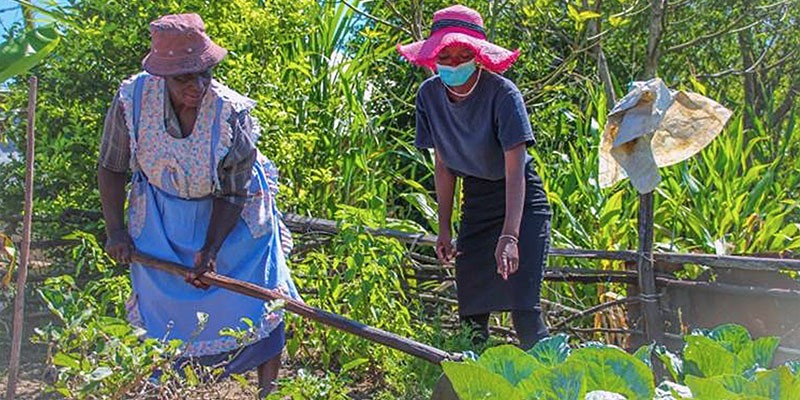
Thanda
Contributed R100 000
Thanda was established in 2008 to provide critically needed support for the increasing number of children who were orphaned or made vulnerable by the HIV/AIDS epidemic. However, Thanda has evolved over the years to provide holistic support for all children and families living in rural communities throughout the Ugu District of KwaZulu-Natal. All of our project staff is hired locally and our varied programmes directly impact nearly 6000 individuals annually. Thanda’s mission is to empower people to create positive change – change in individuals, change in their communities, and eventually changes that impact the world. Our core initiatives aim to develop five core skills: creativity, empathy, self-esteem, perspective, and critical thinking.
Thanda does not receive government subsidies for this programme, which is offered to farmers at no cost. All tools, equipment, and infrastructure remain the property of Thanda and will be withdrawn from the farms if there is a breach of the Memorandum of Understanding. Thanda does not retain any of the profits from produce sales and does not generate an income from the programme other than through sale of agricultural inputs, tractor/implement hire, and milling maize which comprises less than one percent of the total project budget. To support the cost of this programme, Thanda continually researches and approaches appropriate foundation and corporate prospects. Our solar-powered Community Centre, which is the central hub of our operations, is home to six ECD classrooms, a facilitator resource centre, and the municipality’s only library, art centre, and skatepark. During the lockdown, we have also been distributing personal hygiene supplies and food parcels and to households in our community, which we have been able to supplement with fresh, locally grown produce through our Organic Farming Programme.
BBBEE - 100% Black Beneficiaries
Sponsorship – allocated to purchase of New Harrow Disc for ploughing of slopes; Farm-based Training and Mentoring within the Local Community; repair and extension of fencing to localised subsistence farms.
“This is such fantastic news- thank you!!! I am so looking forward to working on this project and positively impacting so many lives together”.
– Angela Larkan (Executive Director - Thanda)
2020
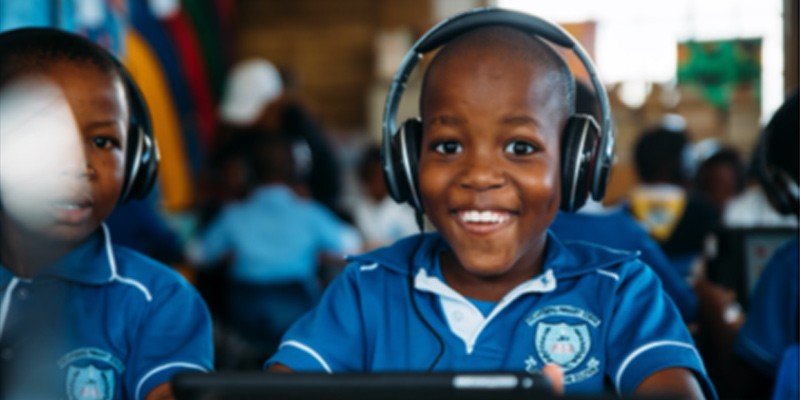
Six Edumeni South Circuit Schools in rural Isandlwana and Rouke's Drift
Contributed R150 000
All six schools are no fee schools and are in extremely impoverished communities. To maximise the impact of teaching programmes through the provision and installation of IT infrastructure in 6 deep, rural schools in Umzinyathi District. These are no fee schools at which KHULA Education provides direct teaching support. Both the learners and educators in these schools are 100% black. Most of the learners in these school come from single parent families and are supported by their grandparents. In the area, unemployment is at 80% and 60% of families live below the poverty line, surviving on social grants. These schools are significantly under-resourced and their isolated, rural location means that internet connectivity is simply unavailable, or slow and sporadic at best. It is a daily challenge for educators and their learners to access learning materials, make applications for study and connect with the wider world. Providing internet to these schools is a priority, if we are to ensure that both educators and learners are able to compete in modern society. The Principals of these 6 Primary and Secondary Schools, to develop a set of individual school-based appeals to KZN Slots to assist the School directly with internet infrastructure. Each school will have the capacity to connect 80 devices to the internet simultaneously. Each device will be granted access using its unique device identifier. This will ensure that usage is managed and safeguard the stability and accessibility of the wi-fi network.
The significance of the Wi-Fi Tower at Isandlwana is that it will, for the first time, make it possible for local schools and community structures to gain reliable internet access. The Principals of local schools, the Tribal Council headed by Inkosi MPM Mazibuko, as well as the Department of Education Circuit Managers and Subject Advisors are supportive of this proposal to KZN Slots as they are aware of the significant impact internet connectivity will have for community development in their area. Further, KHULA Education undertakes to take care of monthly subscription fees, as well as any maintenance that may be necessary. They have gone a step further to address safety concerns regarding routers.
“The last year has proved that the KHULA Education staff and children can rise to any challenge. We have taken full advantage of the pandemic to continue to improve the quality and reach that KHULA Education can offer and education through technology plays an important role. Our successes could not have happened without your support; the installation of the WiFi was a game-changer for us all and the wider introduction of tablets has had a significant effect on how we are able to teach. You have made a viable and significant difference to the lives and futures of 6,000 children and their families and we are enormously grateful. Thank you from our KHULA Staff and Board as well as the local School Principals and Educators. Your support means the world to us all”.
BBBEE – 100% Black
Sponsoship - Sponsorship towards installation of IT infrastructure at these six schools and the localised tower.

KZN Cerebral Palsy Asssociation
Contributed R75 000
Association was established in 1969 and registered as a welfare organisation which strives to enhance the lives and functional independence of children and adults with cerebral palsy. The abilities of people with cerebral palsy differ widely from one individual to another, so do the Centre's services. They teach the educable, train the intellectually challenged and provide loving care and therapy for those most profoundly affected through six facilities - education and awareness; assessment; physiotherapy; occupational therapy; speech therapy; pyschological facilities; day care and residential care. These facilities are open to all, inclusive of those that are in financial distress.
“COVID-19 Pandemic has had a significant impact on the world as we know it. It has changed the way in which we interact with each other, how businesses are run and how we offer and give support. Despite many challenges, however, you have chosen to support us, and this gives us strength. Without you, it would be impossible for us to carry on the work that we do, and we are beyond grateful. We have been exceptionally busy at the Association in preparing our new property to be safe, healthy, and clean for the return of our employees and disabled members. Renovations are underway and we are extremely excited about the coming changes! We believe that change is not only good, but necessary, to sustain ourselves to be able to continue helping those who live with disabilities. Here at KZNCPA, we start every day with a smile, knowing how fortunate we are to be able to carry on the work we do. This work would not be possible if it were not for your contributions, support and donations. Everyone here is grateful daily for the opportunity to continue providing a caring and loving place for our cerebral palsied members. We exist because of you, and your support enables us to be a sustainable organisation” – Lesly Hall, CEO KZN Cerebral Palsy
BBBEE – 95% Black
Sponsorship – Funding for sensory toys and televisions and specialised utensils; cutlery and crockery for the impaired, as well as a computer for the administrative office.

Robin Hood Foundation
Contributed R100 000
The Robin Hood foundation started informally in May 2005 and grew exponentially due to the needs of the community and in 2007 was registered as an NPO. The Foundation has 4 major projects, namely: - Gogo Bags; Love the Babies; Bless a Granny & Grandpa and Hope Breakfast (Child Headed Household). Each project done under the Child Headed Household banner is specifically aimed at orphaned and vulnerable cases and assistance of the Community Liaison is necessary. KZN Slots took this a step further and have funded 10 scholars for the duration of the last three academic years, ensuring that not only do they have their school uniform and stationary needs met, but that their home has the basic food needs met as well.
“Thank YOU and YOUR team for the lifeline you give these children, a blessing that I don’t think we’ll EVER know the full extent of xxx” – Kim Griffith Jones, Co-ordinator Robin Hood Foundation
BBBEE - 100% Black Beneficiaries
Sponsorship – Uniform, school and daily requirements for underprivileged children and child headed- households
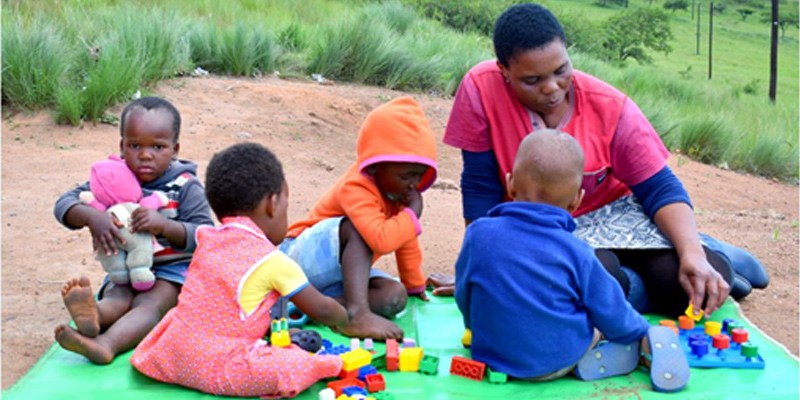
LETCEE
Contributed R110 000
The Little Elephant Training Centre for Early Education (LETCEE) is an Early Childhood Development (ECD) non-profit organization, established in 1993 that works in the impoverished, rural communities in Greytown, where unemployment figures are high and the impact of HIV/Aids and TB is a reality in almost every home. Access to basic services such as health and education remains poor. One of the biggest concerns is the lack of access to ECD services. Fewer than 10% of children between the ages of zero and five years, in this area, are able to access Early Childhood Development services at a crèche or pre-school. To address this gap in children’s education, LETCEE runs four children’s centres in the deep rural communities of Greytown. These centres are converted shipping containers that provide play and learning resources to the children and community. Children can attend playgroups, at which they also receive a wholesome meal, daily. The centres provide a safe space for children – essential in the current social climate in our country. Although designed for pre-schoolers, the centres now provide services to older children too – especially those in Grades 1, 2 and 3 who need a safe place to wait before walking home with older siblings.
“Your donation has contributed to the health, safety and education of more than 200 young children in these deep rural communities. It is greatly appreciated. Thank You KZN Slots”.
BBBEE – 100% Black
Sponsorship - The installation of 3 pit latrines at each of the four Children's Centres.

Woza Moyo
Contributed R100 000
Woza Moyo began in 2000 in direct response to the HIV/AIDS pandemic that was ravaging the Ufafa Valley community. This organization works at a grassroots level going door to door in the community, educating, counselling and monitoring. It is their vision to see all people of the Ufafa Valley community healthy and productive, living in a safe and clean environment with good access to services and social justice. Further, they have made it their mission to facilitate the empowerment of the community through various programmes.
“COMMUNITY MEMBERS CONVERTING HOME SPACES INTO DOOR SIZE DEEP TRENCH HOME ORGANIC GARDENS - As the Covid 19 pandemic progress many community members are worried about food security. Rising of food prices and loss of income are hitting hard the vulnerable people. Higher retail prices will result in more households having to cut down on their food quantity. With potential lasting impact on nutrition and health especially for children and people who are on chronic medication. Woza Moya is implementing 100 door size deep trench organic home gardens across Ufafa valley. Alan Hofland (horticulturalist) trained local women on how to set up a nursery and bookkeeping. These women are expected to look after for their nursery and sell seedlings to community members. Food garden champions were also trained on organic gardens. The selected households will implement organic door size gardens in their homesteads and they will be mentored by food garden champions. “If community members learn how to grow their own food, they will help themselves” says Thuli Mtolo who oversees the Sustainable livehoods programme. Thank you to KZN Slots for partnering with in improving food security”.
BBBEE – 100% Black
Sponsorship - Funding towards training and purchase of raw materials to assist on their Sustainable Livelihood programme to support vulnerable women and families.
Memeza
Contributed R140 000
Social Enterprise geared to empower the most vulnerable communities with tangible safety technology, linked directly with SAPS, Community Policing Forums, Neighbours, Family and Friends. Its vision is aligned to the National Development Plan on Safety… "by 2030, people living in South Africa should have no fear of crime. Women, children and those who are vulnerable should feel protected." Project is in partnership with the Civilian Secretariat of Police Services.
Sponsorship – Safety Technology and maintenance thereof.
It is to be noted that this project was at the request of the KZNGBB and approved on Round Robin prior to the submission of CSI Projects
Organisation of Disability Empowerment
Contributed R100 000
The Organisation for Disability Empowerment is a Non-Profit organisation which renders services within the boundaries of the eThekwini Municipality. The Organisation provides free services to the community such as applications for assistive devices, Early Childhood Development unit for children with disabilities, Referrals for Disability grants, Identity documents, Special schooling, Open Labour Market and Community Outreach programmes focusing on under-resourced and under privileged areas.
“On behalf of Management and Persons with disabilities of whom we serve, we would like to place on record our sincere thanks and appreciation to KZN SLOTS for the generous donation of R100 000. Thank you for allowing us the ability to uplift the lives of persons with disabilities” – Melanie Naidoo, Manager at Organisation for Disability Empowerment.
BBBEE – 100% Black
Sponsorship – Funding a bead work training program, as well the purchase of adult diapers, wheelchairs, buggies and crutches.
Amanzintoti Trauma Centre
Contributed R80 000
Amanzintoti Trauma Unit t/a Turning Point is a non-profit organization specialising in Domestic Violence against abused women and their children. They assist with debriefing and counselling of clients that have been traumatised. Registered with the Department of Social Development as a Safe House. They attend to community outreach programs, inclusive of victim friendly facilities at the Amanzintoti and Umbumbhulu SAPS, and the Rape Survivor Group of GJ Crookes Hospital, as well as run awareness programs and counselling at the primary and high schools in these areas.
“Thank You KZN Slots for your invaluable assistance, particularly in these difficult times. Your sponsorship enables us to help domestic violence victims in our community”.
BBBEEE – 75% Black
Sponsorship - Refurbishment of Safe House facilities and the upgrade of facilities available for the children in their care, as well as improvement on the security and fire safety at the premises.
It is to be noted that due to the need for privacy for victims that are counselled at this Organisation photographs may not be taken.
Reserved Funds Projects

Khanya Hospice
Contributed R5 000
This Hospice attends to the palliative care of terminally ill patients in the rural and semi-rural areas of the Upper South Coast region. Staff work on an outreach basis attending to patients at their homes.
“A BIG “Thank You” to the Management and Staff – and your Corporate Social Investment Company for your wonderful donation to Khanya Hospice. Believe me, this will go a long way and we will be able to help many patients that are on our Home-based care program”. – Neil McDonald, CEO – Khanya Hospice.
BBBEE - 97% Black Beneficiaries.
Sponsorship - Community Outreach assistance
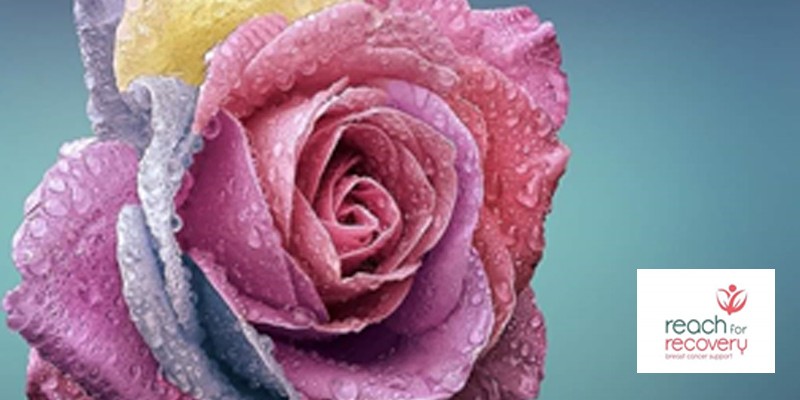
Reach for Recovery
Contributed R27 600
Reach for Recovery is a breast cancer support Organisation which focuses on breast cancer support and awareness. This Organisation is unique as all Volunteers are Breast Cancer Survivors. it is one of the only organizations’ that provides a patient support service on a national basis. This service is done at no charge to the patient. We maintained our sponsorship of 15 mammograms.
“We thank KZN Slots for your awesome and generous support of our charity, once again this year. We are so excited that we have the funds to pay for 15 mammograms and the opportunity to save lives. This donation is huge for Reach for Recovery and makes such a difference, not only to the 15 high risk women but it also helps us create awareness, as word spreads into the communities, that help is available”. – Jenny Caldwell, Regional Chairperson – Reach for Recovery.
BBBEE - 75,5% Black Beneficiaries

Jes Foord Foundation
Contributed R25 000
This Foundation was started by Jes Foord after she was brutally gang-raped in 2008. The experience was incredibly traumatic and like all other rape victims, she had to do her statement, attend a doctor for physical examination and evidence collection. After those grueling hours of having to remain in soiled clothes without a shower, she was gifted a similar pack of items from a local pharmacy and Jess was extremely grateful. The Foundation works to empower rape victims through awareness, support and education programs, which is done via three projects – Comfort Bags; Trauma Counselling and Learner Awareness Programmes. We assisted by sponsoring comfort bags for rape victims.
“A special thank you to KZN Slots for the amazing donation… You have no idea how much this helps the Foundation with ensuring that we can continue to deliver rape comfort bags and create awareness on the message of no means no and what support is available for anyone that is sexually assaulted. It’s people like you who make our job of turning “Rape Victims” into “Rape Survivors” that much easier to do”. - Jes Foord, Director – Jes Foord Foundation.
BBEE – 91% Black Beneficiaries

Chicken Stew for the Soul
Contributed R10 000
As lockdown extends, as does our focus of getting food out to those in need, so we are so excited for this wonderful collaboration with Tony and Guy from Stokers Arms, helping to bring our Chairlady Cindy Norcott’s vision to life to start a Soup Kitchen’ - the latest addition to our covid-19 relief drive Hope is Contagious -Chicken Stew for the Soul! Çook-up’ will start by cooking 250 litres of nutritious and wholesome chicken stew to send out accompanied by 250kg of rice. Cooking from Monday to Thursday and hoping to cook up at least nearly 400 litres of stew every day and get it straight out, through our community partners that we know and trust and have been working with and building relationships with for the past 15 years, directly into the hands of the families that need it.
“Thank you so much for being part of our #EveryDayHeroes drive and supporting our Soup kitchen collaboration with Stokers arms – financially and with your incredible teams! With your help, we sent out over 65 000 meals and 15000 sandwiches through our community partners into the community. Thank you! For helping us to make a difference and be a little bit of a lifeline in the community to those that needed it most!”- Kim Griffith Jones, Co-ordinator at the Robin Hood Foundation.
BBBEE – 99% Black
Sponsorship – Corporate sponsor for 4 days
To be noted that Stoker’s Arm is a KZN Slots site
2019
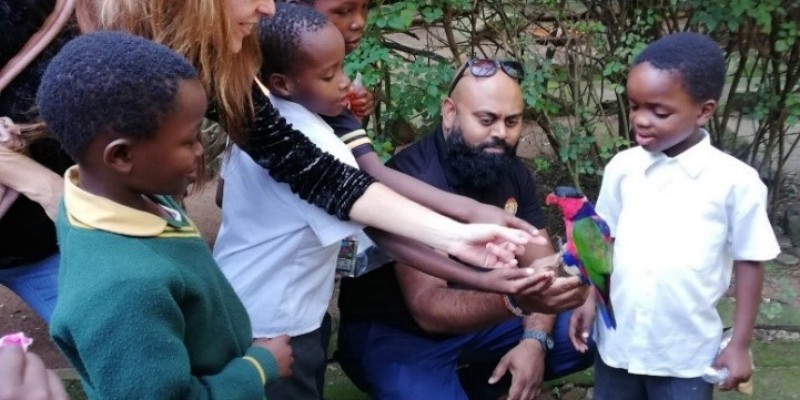
Robin Hood Foundation
Contributed R95 000
The Robin Hood foundation started informally in May 2005 and grew exponentially due to the needs of the community and in 2007 was registered as an NPO. The Foundation has 4 major projects, namely: - Gogo Bags; Love the Babies; Bless a Granny & Grandpa and Hope Breakfast (Child Headed Household). Each project is done under the Child Headed Household banner and is specifically aimed at orphaned and vulnerable cases and assistance of the Community Liaison is necessary. KZN Slots took this a step further and has funded 10 scholars for the duration of the last three academic years, ensuring that not only do they have their school uniform and stationery needs met but that their home has the basic food needs met as well.
“It is always fantastic to catch up with the children and your team at our quarterly interactive that these children definitely don’t get to experience every day and seeing how the children are growing and in fact thriving with the love, accountability and blessings shared by your generous support. After a very special day, each child was safely taken home by the team from Lungisani with their brand new school uniforms, new stationery, brand new school bag, school shoes as well as a big Gogo bag filled with food, toiletries and a brand new blanket, lunch box, etc. Thank you for your valued support, watching these children connect with your team and grow and thrive over the past year is just wonderful to know the impact you are making on their lives!” – Kim Griffith Jones, Co-ordinator - Robin Hood Foundation.
BBBEE - 100% of Black Beneficiaries.

Khula Education
Contributed R71 230
KHULA Education, situated in the heart of rural uMzinyathi District, KwaZulu-Natal, is a non-profit, educational initiative of The David Rattray Foundation. Programmes are designed to give children the chance to lift themselves out of their extremely disadvantaged backgrounds by improving and supporting their education and development, not just sufficiently to pass a set of exams, but also to effectively prepare them for adult life. We assisted by sponsoring the Inter-school Math quiz and Think Tank Debating programmes for the 2019 academic year.
“Through your support we have been able to invite more schools to participate in these events this year, enabling 298 youth from primary and secondary schools to grow their knowledge of Maths and English. These children from deep, rural communities in uMzinyathi District, where there are few opportunities for programmes of this nature. We are so grateful that, through your support, we can continue to offer these innovative activities to local children to equip and inspire them to reach their full potential and make a difference in their families and communities”. – Debbie Heustice, Director: Strategy & Partnerships – Khula Education.
BBBEE – 100% of Black Beneficiaries.
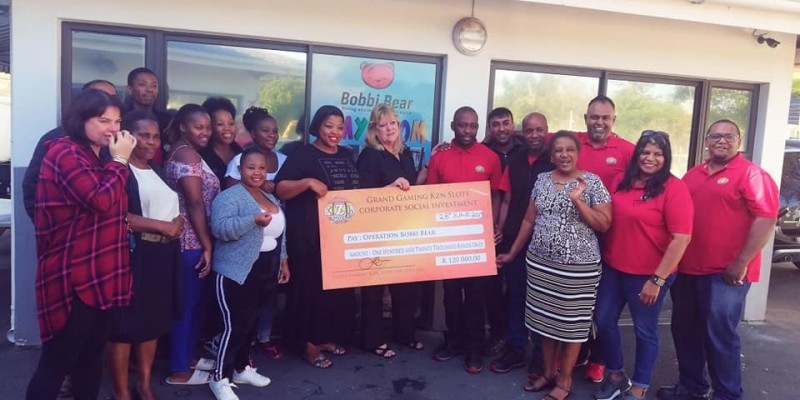
Operation Bobbi Bear
Contributed R120 000
A Human Rights Organisation committed "to rescue, represent and reintegrate raped and sexually abused children, to minimize their risk of HIV/AIDS, and to help them towards wholeness". Bobbi Bear Programmes – Bobbi Bear Rescue Centre; Schools Outreach; Support Groups; Child Safety Officers; Illovo Tree Clinic; Honour Programme. We assisted the Organisation by sponsoring a large fridge and freezer; washing machine and dryer, as well as assisting with a monthly purchase of groceries for the duration of 2019.
“Thank you for standing by us to help relieve the stress and anxiety about where our next meal or source of income will come from so that we can rather focus our time and efforts on the children who have suffered the worst imaginable pain and whose faith in us as adults have all but completely been diminished through the severe neglect and abuse they have been exposed to by the very people they should be able to trust”. – Eureka Olivier, Director -Bobbi Bear.
BBBEE – 96% of Black Beneficiaries

Khanya Hospice
Contributed R30 000
This Hospice attends to the palliative care of terminally ill patients in the rural and semi-rural areas of the Upper South Coast region. Staff work on an outreach basis attending to patients at their homes. We assisted with the purchase of two wheelchairs; medical supplies; suction machines and adult nappies.
“A BIG “Thank You” to the Management and Staff – and your Corporate Social Investment Company for your wonderful donation to Khanya Hospice. Believe me, this will go a long way and we will be able to help many patients that are on our Home-based care program”. – Neil McDonald, CEO – Khanya Hospice.
BBBEE – 97% of Black Beneficiaries.
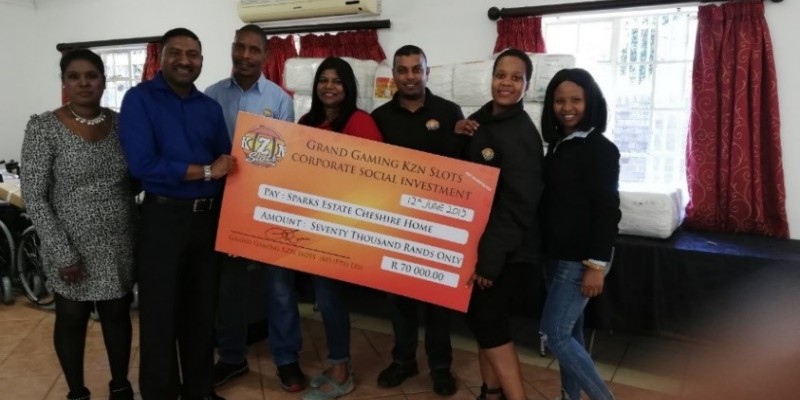
Sparks Estate Cheshire Home
Contributed R70 000
The Home was established in 1979 providing residential care for residents of all communities in the KwaZulu-Natal region and currently houses 41 residents. Most residents come from rural and previously disadvantaged communities. Due to the severity of the disability of the residents, full-time care is a necessary warranting a staff of 27 to adequately meet the needs of the residents. The Home endeavours to prevent the further deterioration of the physical condition of the residents, whilst providing a comfortable living environment and a high standard of care. We assisted with the purchase of twenty wheelchairs; suction machines; adult nappies and a washing machine.
“We thank you most sincerely for your loyal support and donation… your assistance has surely positively impacted our budget. Thank your interest and concern for our special children”. – Roger Gangadoo, Manager – Sparks Estate Cheshire Home.
BBBEE – 98% of Black Beneficiaries.

The Open Door
Contributed R50 000
Open Door is a one-stop trauma and crisis centre. They work with abused women, vulnerable children and families focusing both on prevention (eg. training and awareness) and intervention (eg. counselling and social services). They are also at the forefront, as a registered shelter, in assisting victims of human trafficking. We assisted with a laptop and two sewing machines creating upskilling programs for residents at the shelter, as well as blinds for all the rooms of the shelter.
"From the cocoon of despair... Emerge as fragile as a butterfly, but free".
“Thank you most sincerely for the very generous donation… We really appreciate your amazing support”. – Thora Mansfield, Director – The Open Door.
BBBEE – 89.5% of Black Beneficiaries.
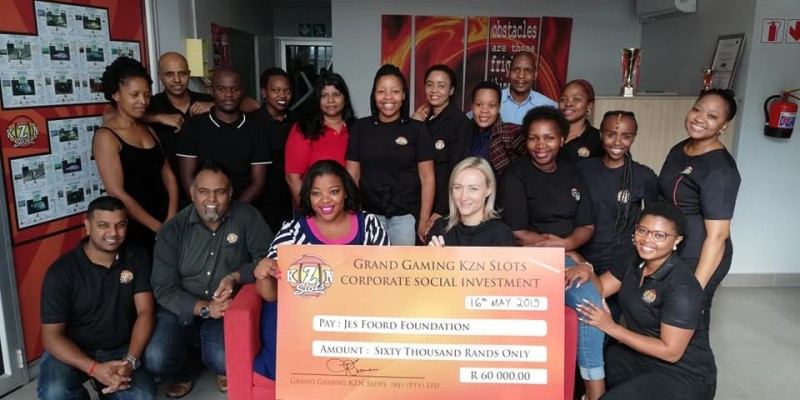
Jes Foord Foundation
Contributed R60 000
This Foundation was started by Jes Foord after she was brutally gang-raped in 2008. The experience was incredibly traumatic and like all other rape victims, she had to do her statement, attend a doctor for physical examination and evidence collection. After those grueling hours of having to remain in soiled clothes without a shower, she was gifted a similar pack of items from a local pharmacy and Jess was extremely grateful. The Foundation works to empower rape victims through awareness, support and education programs, which is done via three projects – Comfort Bags; Trauma Counselling and Learner Awareness Programmes. We assisted by sponsoring and packing 100 Children’s Comfort bags, as well as sponsored 100 Learners to attend Awareness Programmes.
“A special thank you to KZN Slots for the amazing donation… You have no idea how much this helps the Foundation with ensuring that we can continue to deliver rape comfort bags and create awareness on the message of no means no and what support is available for anyone that is sexually assaulted. It’s people like you who make our job of turning “Rape Victims” into “Rape Survivors” that much easier to do”. - Jes Foord, Director – Jes Foord Foundation.
BBBEE – 91% of Black Beneficiaries.

Reach for Recovery
Contributed R87 250
Reach for Recovery is a breast cancer support Organisation which focuses on breast cancer support and awareness. This Organisation is unique as all Volunteers are Breast Cancer Survivors. it is one of the only organizations’ that provides a patient support service on a national basis. This service is done at no charge to the patient. We maintained our sponsorship of 50 mammograms in 2019.
“We thank KZN Slots for your awesome and generous support of our charity, once again this year. We are so excited that we have the funds to pay for 50 mammograms and the opportunity to save lives. This donation is huge for Reach for Recovery and makes such a difference, not only to the 50 high-risk women but it also helps us create awareness, as word spreads into the communities, that help is available”. – Jenny Caldwell, Regional Chairperson – Reach for Recovery.
BBBEE - 75.5% of Black Beneficiaries.
Phathakahle High School
Contributed R150 000
This 43 year old School is situated at Verdriet Farm in Danhauser. It is the only high school in the area and houses 680 learners from four feeder schools. Phathakahle High School provides for the basic educational needs for the Senior Phase (Grade 8 and 9) and Further Education and Training (FET) Phase (Grade 10; 11 and 12). Due to financial constraints and lack of regular maintenance and repair, this School is sadly in a poor state of disrepair. This School has requested the assistance of KZN Slots to help with repairs to the classrooms and refurbishment to the Science Laboratory, as well as for two computers for the Principal’s office and the School Office.
Renovations and refurbishment currently underway.
BBBEE – 100% of Black Beneficiaries
2019 Reserved Funds
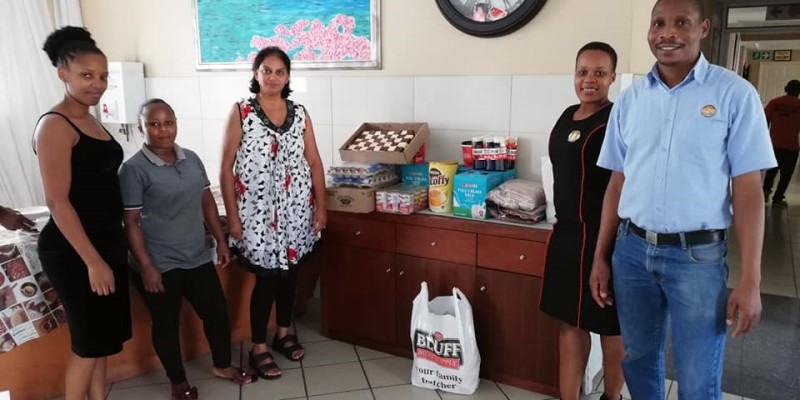
Clare Estate Seniors Association Home
Approached KZN Slots for assistance purchasing grocery items (as per their needs) and invited us to join the residents for tea. Home for the aged.
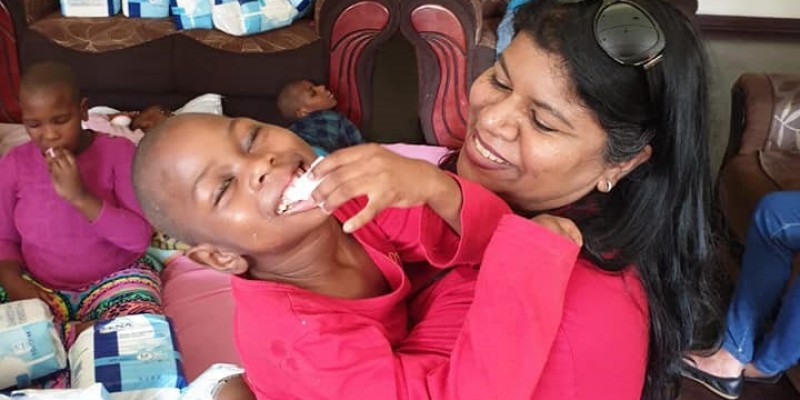
Inqolobane Children’s Home
Approached KZN Slots to assist with purchasing a month’s supply of nappies. The home cares for children with cerebral palsy, as well as children that are physically and mentally challenged.
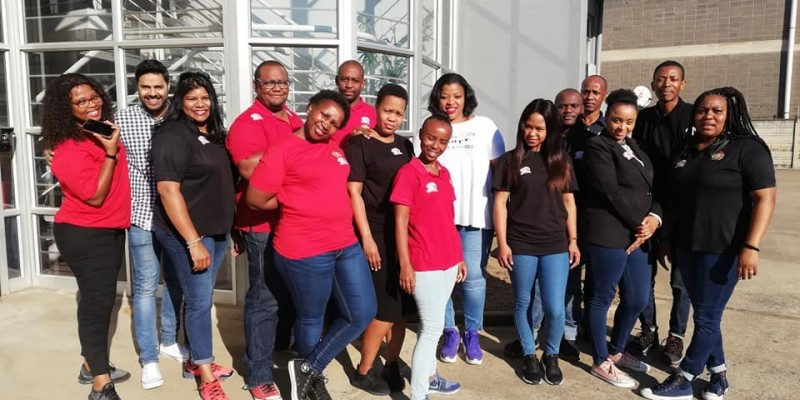
Tekkie Tax
As a Corporate, it is imperative that we create a culture encouraging the ethos of charity. Tekkie Tax is a dynamic project owned; managed and benefitted by Welfare Organisations. It is a singularly focused national Fundraising Campaign that represents more than 1000 NPOs.
We chose to support Education Charities.
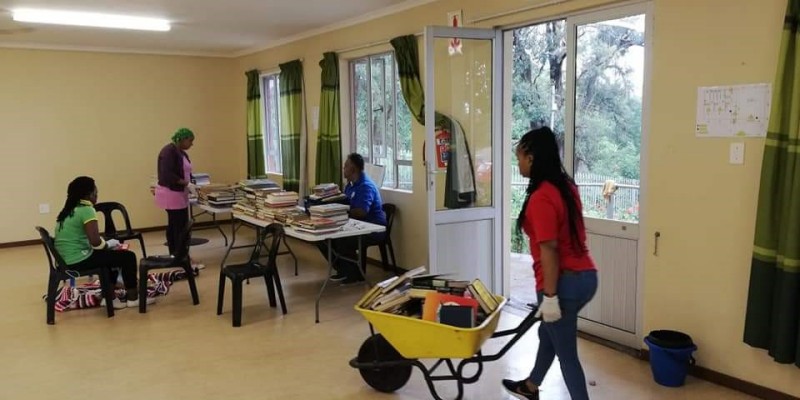
William Clark Garden Home
Renovation and refurbishment of a room creating a library for the children resident at the Home.
All work completed by members of Staff.
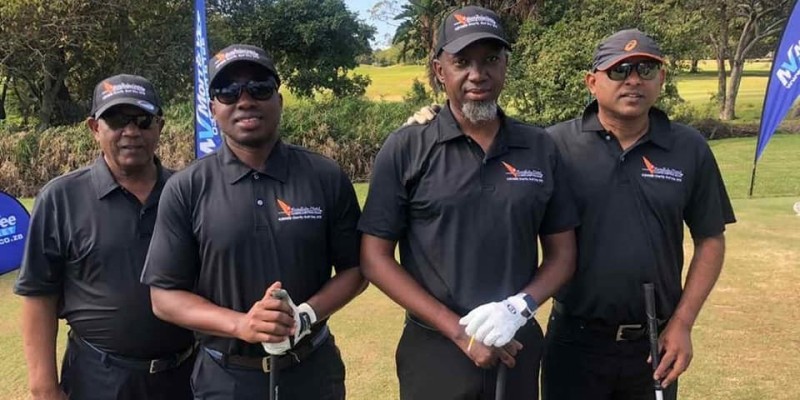
KZNGBB Official Charity Golf Day
Renovation and refurbishment of a room creating a library for the children resident at the Home.
All work completed by members of Staff.

Sunflower Day
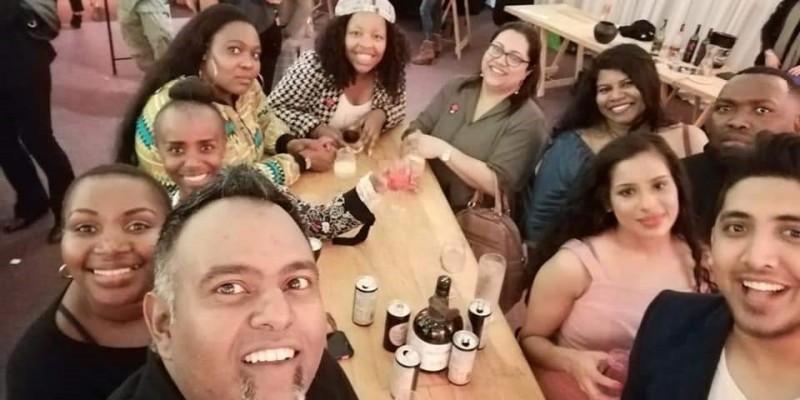
Robin Hood Annual Charity Evening
St Martin’s Childrens Home
Disclaimer – Cannot post photos of the children as they are placed under Court Order.
2019 Mandela Day

Generosity Water

Quadpara Association of South Africa
Sponsorship of 2 wheelchairs to the Association.
Built by our staff as a Teambuild activity on Mandela Day.
2018
Tongaat Anti-Drug Forum
Contributed R35 000
The Tongaat Anti-Drug Forum (TADF) is a community-based organization formed in 2000, to address the spiralling drug problem in Tongaat. The Organisation’s strategy in addressing this burgeoning drug problem is a multi-disciplinary approach, which includes education around the drugs, rehabilitation program and preventative measures. These three strategies are the pillars of the Organisation’s campaign to address the drug problem in the Tongaat area. Further, TADF’s clarion call is “The world will not be destroyed by those who do evil, but by those who watch them without doing anything”. In light of this motto, TADF has held marches to the homes of drug dealers and had coverage of same on national television. Awareness is key to fighting this epidemic and TADF focus on the youth of the community. KZN Slots has funded the prize money for the annual Tongaat Schools Anti-Drug Awareness Competition. Competition awards evening to be held on October.
Beneficiary Analysis – 75% Black; 20% Indian and 5% otherRobin Hood Foundation - Lalelani Primary
Contributed R100 000
The Robin Hood Foundation is an organisation that advocates its existence to solely both rescue and uphold the rights of women, children and the elderly through a passion for connecting those that have with those that need whilst bearing compassion that ceases to fade. Buy-a-Build is one of the projects that serves communities very well. They focus heavily on Early Childhood Development, as it is vital to get the foundations right for small children to be able to learn and grow to their full potential with the belief that education is the main key to eradicating poverty.
While statistics have proven that the first five years of a child’s life are fundamentally important as the foundation that shapes children’s future health, happiness, growth, development and learning achievement at school, in the family and community, and in life in general, a growing body of research has found that school facilities can have a profound impact on both teacher and student outcomes. With respect to teachers, school facilities affect teacher recruitment, retention, commitment, and effort. With respect to students, school facilities affect health, behaviour, engagement, learning, and growth in achievement. Thus, researchers generally conclude that without adequate facilities and resources, it is extremely difficult to serve large numbers of children with complex needs.
Whilst building Siyanda Crèche in Ntshongweni last year, the Organisation spent a substantial amount of time in this community and it became abundantly apparent the need to focus the ‘Buy-a-Brick’ campaign at Lalelani Primary which is situated just in front of the crèche, to make a positive impact in this community.
Whilst there is so much that needs repair, as the structure was built in 1977 an had little to no attention since then apart from Principal Mathe painting the roof – from his own pocket – and the parents trying their best to ‘build on’. The school structure needs work on its poor ablution facilities; broken windows; water damaged classrooms; a dire need to paint the entire school; a safe and new kitchen container, where they cook for the 677 children one meal daily; Jo-Jo tanks and work on the water drainage system; an outdoor play area and school supplies.
“A big thank you for generous support of our Buy-a-Brick 2018 campaign with this INCREDIBLE and unexpected donation of an amazing R100 000 towards the project!! As well as support what we can only call an ‘Epic’ Mandela Day for the 700 children at Lalelani Primary! What an exciting and special day for these 700 children! So many of them are orphaned and vulnerable cases and being so rural, they’ve never had the opportunity to share in the love, joy, excitement and whole experience of what we shared with them yesterday! To top it off, each and every child went home with a brand new pair of school shoes, toys, toiletries, food, treats, stationery and big smiles with hearts filled-up with love. Our Buy-a-Brick 2017/8 campaign has had us working in this community for the past year and a half, last year building Siyanda Creche – above the Primary school, who also joined us yesterday - and this year uplifting Lalelani Primary; building their new ablutions, multipurpose sports field, playground, renovating classrooms and uplifting the exterior of the school too.
The words of a 12 year old Grade 7 scholar who gave a brief speech as the event started yesterday, “We will never be able to thank you enough for what you have done for us and our school, the last months having you at our school has been the best months of our lives, for the first time, we have had something to look forward to” – completely touching and a beautiful reminder of how when we stand together as a community we can make such a difference in the lives of others! Thank you for your generous support always and helping us to make a difference to these children!” – Kim Griffith Jones, Co-ordinator Robin Hood Foundation.
Beneficiary Analysis – Lalelani Primary 100% Black Learners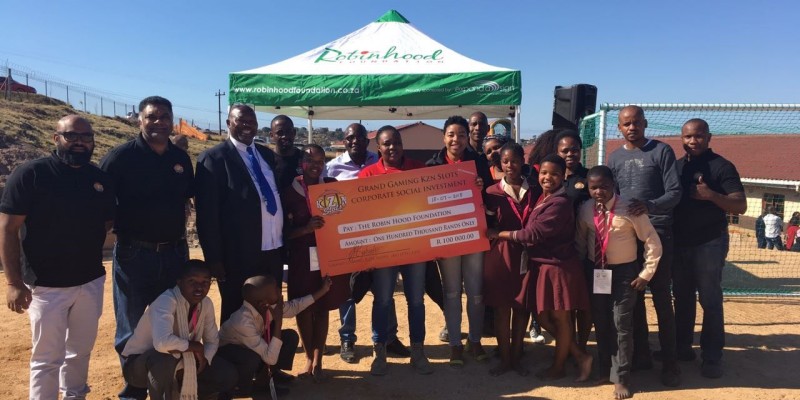
Robin Hood Foundation - Hope Project
Contributed R85 000
The Hope Breakfast project is housed under the Child Headed Household banner and is specifically aimed at orphaned and vulnerable children. This project tries to inspire HOPE, after the devastation they have suffered, through volunteer interaction and support with necessities. The Robin Hood Foundation, with the assistance of Community Liaisons, take orphaned children on a day of shopping to purchase school uniforms, toiletries and stationary. The children are then treated to a meal and spend time with our Team Members, and are then sent home with their school goodies, a hamper full of food, towels, blankets and a toy. KZN Slots took this a step further and began funding ten Grade 1 scholars in 2017, ensuring that not only do they have their school uniform and stationary, but that their home has the basic food needs met. We meet with our kids, who are currently in Grade 2, twice a year and the positive impact this interaction and funding has had is evident in their academic results.
“Just received progress reports on our kiddies! Look how FANTASTIC they are doing and have improved their marks, particularly, Samekelo and Amahle, both of whom we have formed a bond with. THANK YOU to KZN Slots for investing in them! It is true, hope and love do go along way! Have a beautiful day and thank you again for all your hard work in arranging yesterday – it was such fun for the children – their smiles were just priceless!” - Kim Griffith Jones, Project Manager of the Robin Hood Foundation.
Beneficiary Analysis – 99% Black Beneficiary

Reach for Recovery
Contributed R70 000
Reach to Recovery is an international breast cancer support group. It is affiliated to International Union Against Cancer (UICC). It is a non-medical programme designed to help women with breast cancer in their return to daily life. In South Africa, Reach for Recovery is an autonomous non-profit Organisation run by volunteers since late 1960’s.
Reach for Recovery is a breast cancer support Organisation with a unique focus on breast cancer support and awareness, hence the request for funding to cover the costs of mammograms. Further, it is one of the only organizations’ that provides a patient support service on a national basis. This service is done at no charge to the patient and is available to any woman who requests it.
“We are so humbled and thankful to KZN Slots, for choosing Reach for Recovery to be a recipient for your generous donation of R70 000 to provide 50 Mammograms to women who do not have medical aid, or access to this life preserving screening. This is truly a life-saving gift. As breast cancer survivors ourselves, we are passionate in spreading awareness, and the vital importance of early detection. Mammography screening is not readily accessible to a very large section of our population, and the waiting lists at Government Hospitals are very long, due to vast numbers, also the equipment is often not working. As a registered non-profit Organisation, we rely solely on fundraising and sponsorship. So, we thank you from the bottom of our hearts, for your kindness and generosity, and helping us to continue to make a real difference.” - Jenny Caldwell, Regional Chairperson, KZN – Reach for Recovery.
Beneficiary Analysis – 75.5% Black Recipients.
KZN Blind & Deaf Society
Contributed R50 000
The mission of the Talk Sign Campaign is to create awareness among the South African hearing community, which will make them sensitive to the needs of the Deaf and hearing impaired. It is our human instinct to want to communicate with one another. Imagine how lonely it must be when you don’t understand what the people around you are saying, and nobody understands what you are trying to say. This is how people who are Deaf feel around those who do not understand South African Sign Language (SASL). Talk Sign promotes sign language, and in turn, enables two-way communication. The long-term plan is to fully integrate our Deaf community into schools, social and competitive sports, the workplace and all aspects of life. In a nutshell, the Talk Sign campaign aims to have South African Sign Language (SASL) approved as South Africa’s 12th official language.
“The Kwa-Zulu Natal Blind and Deaf Society express their heartfelt thanks and appreciation to KZN Slots for the magnanimous donation of R50 000… (your financial assistance) provides support to the Blind, Deaf, DeafBlind and Multi-Disabled persons over the past 81 years… your contribution has helped us in a meaningful way.” – Sharmila Surjoo, Director KZNBDS (Durban).
Beneficiary Analysis – 98% Black Beneficiaries.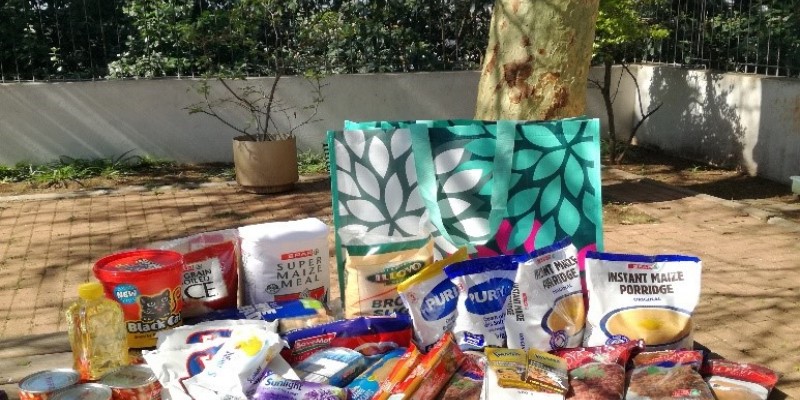
Sheperds Keep
Contributed R15 000
Shepherd’s keep was founded by Colin and Cheryl Pratley in 1998 through their vision to create a haven of love for tiny babies, discarded firstly by their mothers and then by society. Shepherds keep has become synonymous with excellence, high-standards and uncompromising integrity. A transitional home for abandoned/orphaned babies whether HIV positive or not, the immediately apparent difference is that this is not merely a storage facility for cast-off babies, but a place of excellence where a baby’s first months of life are nurtured in the most loving and secure environment, restoring them to health, physically and emotionally. Instead of our babies being doomed to a life in institutions or foster care, they have new beginnings with loving families and they retain the privilege of keeping in touch with most of the babies, watching them flourish and grow with their forever families in Denmark, Canada, England, America, Italy and Holland, as well in South Africa.
“We are truly blessed to be able to help those in dire need… thank you for helping us.” – Michelle Potgieter, Sheperds Keep.
Beneficiary Analysis – 100% Black Beneficiary Base.
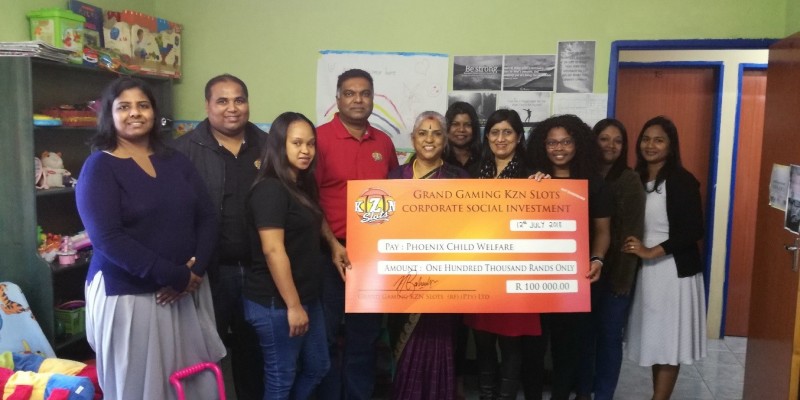
Phoenix Child & Family Welfare Society
Contributed R100 000
The Phoenix Child & Family Welfare Society render social work services to the communities of Phoenix, Mount Moriah and Mount Royal. Due to the extremely high caseloads at the Child Welfare Departments, Social Workers are unable to give children, adolescents and families long term, specialised therapy needed to work through traumatic experiences like sexual, emotional and physical abuse; neglect; exposure to violence; hijacking and robbery; death and loss; etc. Children are not supervised and adequately cared for; children in the community are sexualised due to exposure to inappropriate sexual behaviours. Consequently, there is an increase in children abusing children. Our children are emotionally deprived. They are vulnerable because of the high level of violence, addiction to drugs and alcohol in the community. Child suicide and family murders are a common occurrence in the community.
The play therapy centre at Phoenix Child Welfare creates a warm, caring child friendly environment that promotes healing and empowerment. Therapy is vital in ensuring an emotionally healthy child, and later, adult. The effects of abuse and trauma have huge negative impact and a lack of therapy will allow that childhood dysfunction will creep into future generations and cycles of abuse and violence will continue in our community. We assisted by funding the Play Therapy Centre a psychologist. “It is easier to build a strong child than to repair a broken adult.” – Fredrick Douglass
“Your contribution will indeed assist us in the operation of the Society, as we are helping the many underprivileged families and individuals in our community, who have been severely abused and traumatised, and are in desperate need of counselling and therapy. Your noble act towards helping uplift our community is laudable… there exists no greater service than the service rendered to mankind” – Aroona Chetty, Director Phoenix Child Welfare.
Beneficiary Analysis – 100% Black Designated Beneficiaries.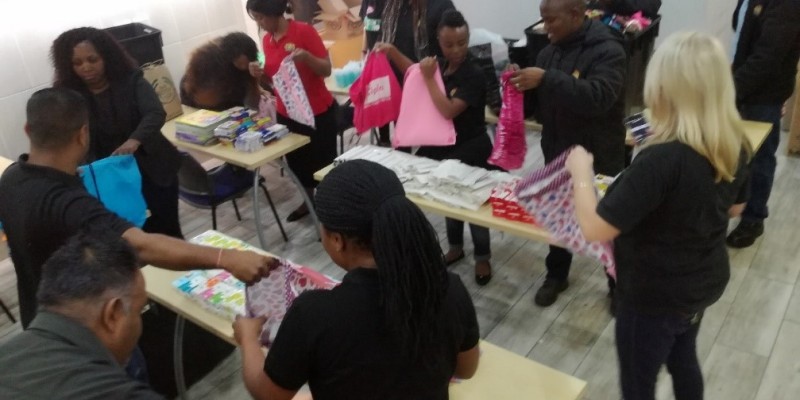
Jes Foord Foundation
Contributed R40 000
This Foundation was started by Jes Foord after she was raped in 2008. The experience was incredibly traumatic and like all other rape victims, she had to do her statement, visit a doctor for physical examination and evidence collection. After those gruelling hours of having to remain in soiled clothes without a shower, she was gifted a similar pack of items from a local pharmacy and Jes was extremely grateful. The Foundation works to empower rape victims through awareness, support and education programs, which is done via three projects.
- JFF Comfort Bag – is a handbag that is delivered to Thuthuzela Centers and Police Stations for rape victims.
- Trauma Counselling – trauma counselling is free to sexually assaulted victims and their families with the Foundation bearing the cost thereof.
- Awareness Program – this program targets learners in the Marianhill, Chatsworth, Embo, Hammersdale, Durban Point, Cleremont, Scottburgh and Valley of 1000 Hills areas and teaches of what to do if raped, the importance of speaking out, no means no and self-esteem to empower them to make changes going forward which is critical.
“A special thank you to Grand Gaming KZN Slots (RF) (PTY) LTD for the donation of R40 000 towards our handbag project and our 2018 Awareness Intervention. You have no idea how much this helps the Foundation with ensuring that we can continue to deliver rape comfort bags and create awareness on the message of NO MEANS NO. It’s people like you who make our job of turning “Rape Victims” into “Rape Survivors” that much easier”. – Jes Foord.
Beneficiary Analysis – 92% Black Designated Beneficiaries.
Issy Geshen Lamont Home for the Aged
Contributed R50 000
The Durban Bantu Refuge Home (located in Lamontville, Durban) was established in 1960, against the will of the Native Administrative Board, who proposed converting the home into a hostel for black women. Mr Geshen fought this proposal and won, resulting in the home providing vital shelter and holistic care for the elderly. Following the death of Mr Geshen in 1979, the committee of the home resolved to rename the home in honour of the man who inspired its creation. The home was registered as an old age facility in 1980, to qualify for a government subsidy and acquire the services of a state doctor.
Since its inception, the home has provided and continues to provide comprehensive and holistic services and care to frail and indigent black African elderly people - who for varying reasons cannot live with family or alone - and, as their only source of income is their government pension, cannot afford the more well-resourced/financed old aged homes. Ageing is an important biological phase in an individual's lifetime and impacts the entire family and community. The plight of elderly persons, in the absence of family support systems and social protection measures makes their vulnerability to abuse and neglect inevitable, especially in communities plagued by poverty, crime and unemployment.
Residential care is a solution in ensuring that vulnerable elderly people live out the remainder of their lives free from any form of abuse and enjoy the quality of life enshrined in our Constitution and Bill of Rights. The Issy Geshen Lamont Home’s primary objective is to provide comprehensive and holistic care and services that promote the physical, emotional and social wellbeing of our residents. “A society that does not value its older people denies its roots and endangers its future. Let us strive to enhance their capacity to support themselves for as long as possible and when they cannot do so anymore, to care for them.” - (Nelson Mandela, 17th December 1988)
“On behalf of the residents, volunteers and staff of the Home, I convey our heartfelt appreciation and gratitude to KZN Slots for the generous donation of R50 000 for the purchase of medical equipment and supplies. KZN Slot’s donation is an investment in safeguarding and promoting the dignity and well-being of our elderly residents.” – Derick Houston, Issy Geshen Lamont Home for the Aged.
Beneficiary Analysis – 100% Black Recipient Profile.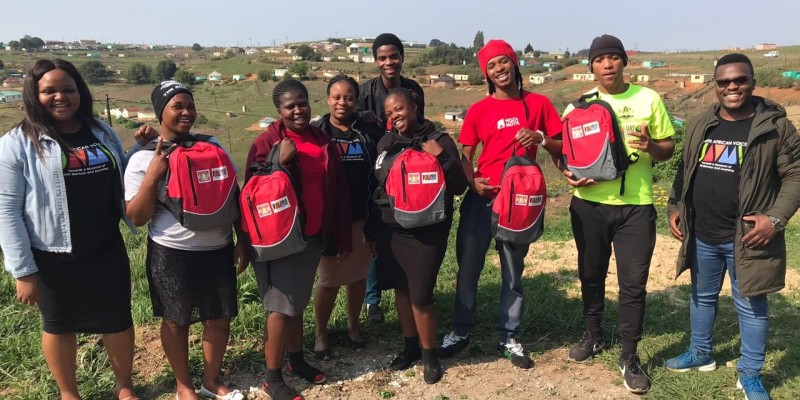
UKZN / InfoAfrica
Contributed R40 000
info4africa is responsible for the conceptualization and ongoing development of the South African Voices HIV Museum. This is the first museum of HIV in South Africa. Established by info4africa in July 2016 as a legacy project of the International AIDS Conference, this museum is a safe and dynamic space for all people to learn and engage on the topic of HIV in South Africa. The museum has been very well received by the HIV service community and enjoys an excellent working relationship with local and provincial government. With its fresh approach to conveying HIV-related materials, these SAVY youth peer educators are taught and equipped to facilitate educational tours for schools, local and international visitors.
The value of experiencing SA Voices is clear in this comment from our SAVY youth, “Learners arriving at SA Voices seldom have HIV at the top of their learning agenda. They quickly find that they are interested, excited, asking questions that society does not allow them to ask, and getting the right answers. They leave inspired. Youth tell us they want us to bring SA Voices to their communities.” Recognising the value of SA Voices, many of our youth and other visitors have appealed to us to think about mechanisms to expand the reach of SA Voices to marginalized and underprivileged youth who are not able to visit the flagship SA Voices Museum in central Durban. Hence, the SA Voices SAVY Backpacks as a direct, innovative solution to reaching out to underprivileged and marginalized youth in hard to reach communities in KwaZulu-Natal. The SAVY backpacks offer unlimited opportunities for taking the SA Voices materials and knowledge out of the Museum and into community spaces such as taxi ranks, train stations, clinics, community halls and ad hoc community workshop spaces.
The current backpack contains two large, durable banners suitable for use in community workshops. Banner 1 unpacks the mystery of HIV by focusing on HIV basics and encourages youth to test for HIV. Easy to use peer educator fact sheets complement this banner. Banner 2 focuses on the drivers of HIV in society. Designed as a game, the banner used together with quiz cards helps youth to have conversations about situations in their communities that may be more high risk in the context of HIV. Banner 3 deals with TB. The advantage of the backpacks is that they are light, portable and we can add contents to them as funds permit. The SAVY backpacks are a true credit to the SA Voices concept of providing platforms for South African voices to be heard on the topic of HIV. Most notably, this project is an excellent example of a youth lead intervention that will continue to make a difference to the people of South Africa.
“The UKZN Foundation thanks you most sincerely for your generous contribution for the SAVY Backpack Project. Your donation helps us fund our vision to… improve teaching and learning, enhancing and expanding our research horizons, supporting students in need and improving our teaching and learning environment. Through your support, we are able to make a difference in the lives of our students and graduates which in turn makes a difference within the communities we serve”. - Prof Anesh Maharaj Singh, on behalf on the UKZN Foundation.
Beneficiary Analysis – 100% Black Recipients (SAVY Backpack Project)
Singakwenza
Contributed R15 000
Singakwenza, meaning “We can do it!” is a charity organisation which aims to build sustainable Early Childhood Education programmes in economically disadvantaged areas, using resources made from recycling. Focus is on the critical development years in a child’s life (between 1 and 5 years). Research around the world has shown that the best way to break the poverty cycle is through education, but our South African education system is in a crisis.
The need is in helping children to build their educational foundations and, as almost 80% of a child’s brain potential is established by the age of 4, there is a need to provide children under 5 with as many opportunities to learn through play as possible. The team at Singakwenza has therefore, developed a variety of toys and teaching materials made purely from recycling. The parent or educator only needs a pair of sharp scissors and a marker pen and she will be able to get all the rest of the materials needed to provide an educational, fun-filled environment for the children in her care - from the bin! Bread bags become skipping ropes, polystyrene vegetable trays become puzzles, yoghurt containers become shape sorters and margarine containers become cars. And if the toy breaks, it is easy (and free!) to make another one. The organisation offers a mentorship programme to crèche teachers and primary caregivers, helping them to understand how to use the toys to provide a stimulating, educational environment for their children, so that these children enter school intellectually, physically and developmentally prepared.
“On behalf of the beneficiaries of the Singakwenza programmes, we would like to thank you most sincerely for your wonderful donation.” Giselle van Wyk, Singakwenza.
Beneficiary Analysis – 98% Black; 0.9% Coloured and 0.4% Indian.Mandela Day 2018 Projects
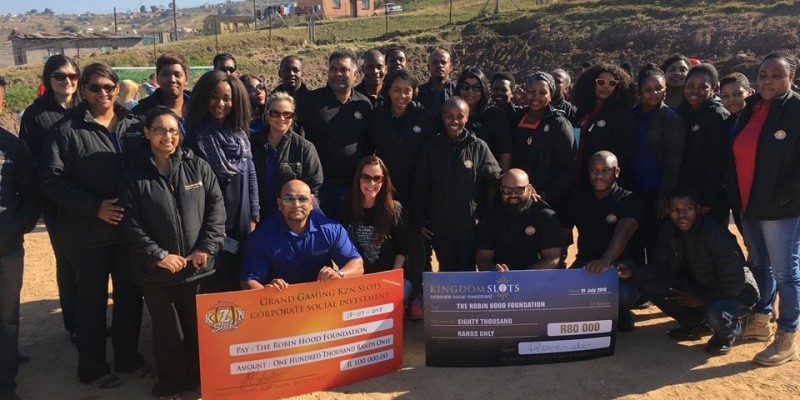
Lalelani Primary – Robin Hood Foundation

Morrestor Children’s Home, Newcastle
"Thank you KZN Slots for the lovely warm blankets the children are so happy. You guys rock." - Morrestor Children's Homes.
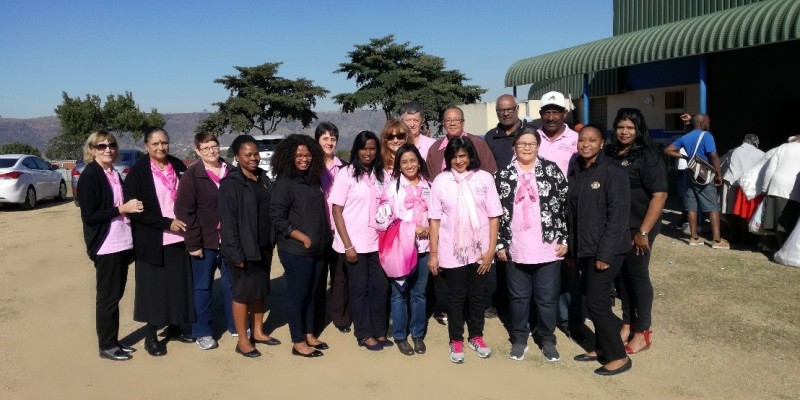
Reach for Recovery – Opening of Clinic at Kwandengezi
"Breast cancer awareness in our rural communities is so desperately needed. Due to the lack of information, patients are often diagnosed when it is too late. Reach for Recorvery Durban recently trained local vounteers, and launched a support group in Kwandengezi. The people streamed in... and the queue kept growing until the hall was filled to capacity. We received a wonderful life-saving donation from a local company, KZN Slots, who donated R70 000 to provide 50 mammograms, to women at high risk, and met the criteria. What a privilege it was to take our message of hope and breasr cancer awareness to the community, who received us with such warmth and appreciation. This was a wonderful day of interesting talks, information, entertainment and sharing. All guests treated to a wonderful lunch." - Reach for Recovery.
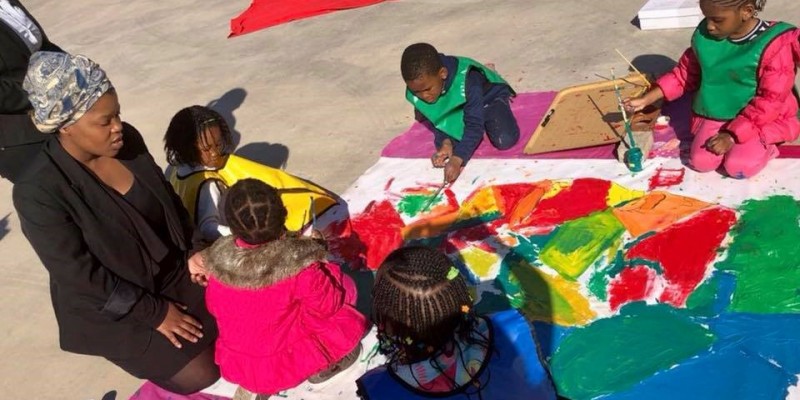
KZN Children’s Hospital
The KwaZulu-Natal Children’s Hospital (formerly known as the Addington Children's Hospital) was built in 1928 and was the first hospital for children on the African continent. In 1984, at the peak of the huge combined internal and international struggle against Apartheid, the wards of the Hospital were closed by the Apartheid government as the hospital treated children of all races. The hospital remained closed for an astounding, 28 years.
Since the end of 2009, members of the KwaZulu-Natal (KZN) Children’s Hospital Trust, together with the KZN Department of Health have been working together to plan the renovation, refurbishment and re-establishment of the old Children’s Hospital (now renamed the KZN Children’s Hospital). The KZN Children’s Hospital, once completely re-established, will be part of the creation of a provincial ‘first’ Health Precinct and proposed inner city regeneration project that will address adult and child health and welfare issues, poverty and urban renewal in Durban’s inner city.
The KwaZulu-Natal Children’s Hospital Trust and other relevant stakeholders are now working together to re-establish the KZN Children’s Hospital as a comprehensive paediatric and child health hub for treatment, prevention and care, including rehabilitation, psychological and social benefit support services, community outreach and training. The hospital will build local capacity of health workers and researchers, as well as support community mobilisation and development.
“On behalf of the KZN Children’s Hospital Trust, I would like to thank you all for coming down to the hospital on Mandela Day in support of our project to re-establish the KZN Children’s Hospital. Thank you for your generous contribution of R35 000, representing 100 bricks for each of your 35 staff members, towards our Buy-a-Brick campaign – know that by buying bricks, you are helping build our 6-storey “Rainbow Tower”! Your contribution is significant as it ultimately contributes to the health of the children of Kwa-Zulu Natal.” – Taryn Miller, Finance Officer The KwaZulu-Natal Children’s Hospital Trust.
2018 Additional Projects
Sunflower Fund
Bandanas purchased for all members of staff
Sunflower Fund aims to educate and recruit a viable source of well informed, potential bone marrow stem cell donors who are ethnically diverse, in an effort to save the lives of those needing a transplant when suffering from leukaemia and other life-threatening blood disorders. It also strives to maintain the associated donor records of the South African Bone Marrow Registry to worldwide standards.
Bartle House
A non-profit organisation situated at 300 Bartle Road in Umbilo, Durban. The home was founded in the 1800's by Mrs Jonathon Peel under the name of "The Durban Homes for Men" and has been serving the community for over 100yrs and at present accommodating 90 social pensioners (men and women). Their main objective is to assist social grant pensioners by providing a safe, happy and well-maintained environment for them to live in. The home is run with integrity and is open to senior citizens of all races and denominations. We assisted the residents of the Home by adding to their Christmas Goodie bags… spreading a little Christmas cheer.
Fairhaven Primary
Primary school in the Bayview, Chatsworth community. School approached KZN Slots via our FaceBook page requesting assistance for their Christmas initiative. The school has a Christmas dinner for their learners and their immediate families, which included dinner and a small gift for each learner handed to them by Santa. For some learners it is the only gift that they will receive.
Wyebank Primary
Primary school situated in the poorer community of Motalabad, Wyebank. Assisted this school with the purchase of sporting equipment for their eager young learners.
Casual Day
Stickers purchased for all members of staff
For Casual Day 2018 this year, we call on YOU to be a protagonist for change! To be a hero for yourself, for others and for our country.
Now, more than ever, South Africa needs people to dig deep inside themselves, find the hero within and BE AN EVERYDAY HERO with persons with disabilities.
This is our 2018 theme that will take us a giant step closer to our ultimate goal:
- a nation that excludes no one
- a nation that upholds everyone’s human rights and works for full inclusion
- We want a South Africa in which all people have equitable opportunity and equal access to education, jobs, justice and more
Help us raise this banner in 2018. You are called upon to BE AN EVERYDAY HERO with persons with disabilities on Casual Day Friday 7 September!
Every one of our successes starts with raised awareness and community spirit in action. Every assistive device bought and handed over to someone who needs it; every training and job creation project; every building or educational institution that is designed with all users in mind…Being a Casual Day Hero is easy! All it takes is getting your Casual Day sticker and encouraging as many people as you can to get theirs for a donation of only R10! Be part of the team by telling everybody you know about Casual Day, by encouraging them to support Casual Day and by helping them understand why persons with disabilities deserve equity alongside all other South Africans, Because Casual Day is as much about raising awareness as it is about raising money.


